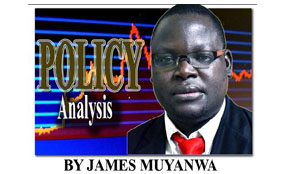 THE revocation of two Statutory Instruments (SIs) by Finance Minister Alexander Chikwanda has once more stirred up the question of whether some investors could be engaged in sabotaging economies in host African countries, including Zambia.
THE revocation of two Statutory Instruments (SIs) by Finance Minister Alexander Chikwanda has once more stirred up the question of whether some investors could be engaged in sabotaging economies in host African countries, including Zambia.
Mr Chikwanda announced the revocation of SIs number 33 of 2012 and 55 of 2013 almost a fortnight ago to save the Kwacha from further deterioration following months of poor performance.
The SI 33 which was introduced in 2012 amid strong opposition from investors was aimed at banning the use of foreign currencies in local transactions.
The SI which became known as anti-dollarisation regulation was signed on May 7, 2012 but took effect on May 18 the same year to proscribe the quoting and pricing of goods and services in foreign currency.
Sometime last year, I had a discussion on the matter with two officials from Currency Exchange Fund (TCX) of Netherlands who had been in Zambia.
TCX senior vice-president Per van Swaay who was accompanied by another official, Gema Perez, told me that the policy was effective in de-dollarising the Zambian economy.
Another result of SI 33 was the increased demand for Kwacha funding from Zambian companies.
The scenario, however, seems to have later changed as local companies seemed to have been spending more on importation of goods and services, thereby augmenting the demand for the dollar.
Coupled with other factors, which, like I stated in my article of March 19 2014, included the erratic release of the dollar into the local economy due to reduction in the portfolio investment inflows used to finance the current account deficit, this led to the shortage of the dollar locally.
This in turn, obviously, resulted in the fall in the value of the Kwacha against the major convertible currencies, except the South African Rand.
The SI 55 was signed by Mr Chikwanda on June 2013 to enable the Bank of Zambia (BoZ) monitor transactions and the foreign exchange inflow.
It enabled the Bank of Zambia (BoZ) to put in place measures for monitoring all transactions that involved the sending and/or receiving of funds.
The main objective was to monitor balance of payments in a transparent and accountable manner.
It revoked SI number 32 of 2013.
Principally, both of the regulations were passed to support the execution of monetary policy and help to stabilise and strengthen the local currency against major international currencies.
The value of the Kwacha, however, depreciated rapidly, especially with the start of this year and by March 15 2013 it had hit the K6/US$-mark twice on March 6 and 14.
It had, as at March 14, lost about 9.3 per cent of its value since December 31 2013.
As I indicated in my last article it hit a low of K6.10 to a dollar on a fortnight ago, extending its losses.
Before that, the BoZ had vainly moved to try and hold back the local currency’s free-fall by offloading $178 million of its international reserves.
By the time Mr Chikwanda was announcing the revocation of the two regulations, the Kwacha had depreciated by up to 13 per cent since the last quarter of 2013.
According to Bloomberg, the Kwacha’s value had dropped by more than 13 per cent against the dollar this year, more than any other African currency the media house tracked.
Fitch Ratings stated the same day that the Zambian unit had been hit by copper prices that had dropped by 13 per cent since January 1 and policy announcements that damaged business confidence.
A weaker currency may stoke inflation in Zambia’s import-dependent economy and push up costs of repaying foreign debt, it said.
Drastically, the currency gained as much as 3.4 per cent and traded 2.9 per cent stronger at K6.152 per dollar in Lusaka, the biggest rise since December 24, 2012 and the world’s best performer for that day.
The Kwacha had earlier in the day traded as much as one per cent weaker.
Comforting as that report may have been, it raised a question as to whether the poor performance of the Kwacha was a natural response of the market forces towards the economic conditions which prevailed at the time!
Could it have been a gimmick by the investors and other economic players who, from the onset, had vehemently opposed the introduction of SI 33 and SI 55 to blackmail the Government?
It is possible that these forces had formed cartels and held on to the dollar to squeeze the local economy and arm-twist the Government into revisiting the two regulations.
Some observers, like former Republican Vice president Enoch Kavindele, think this could be so!
And if that is the case then there is the deep-seated question of who is in control of economies in African countries including Zambia?
For comments/other contributions call: 0955 431442, 0977 246099, 0964742506 or e-mail: jmuyanwa@gmail.com.






